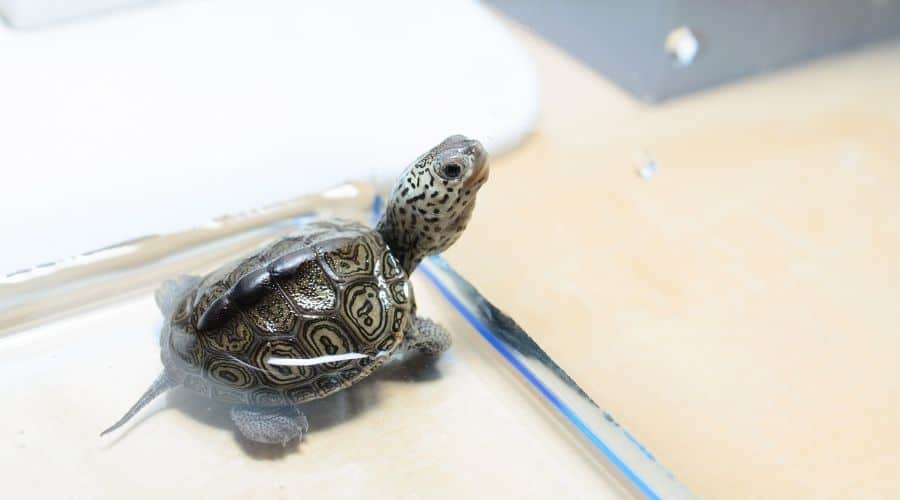Turtles are incredibly tough creatures that can survive a lot with their shells, but they can still get bacterial infections. Turtles with bacteria problems often display lethargy or wildly erratic behavior.
Fortunately, there’s plenty you can do for a bacterial infection, especially if you catch it early. Why is my turtle staying in one spot?
Your turtle is staying in one spot because he’s sick. Some sick turtles opt for frantic movement, especially when they’re disoriented or in pain, others are lethargic and stop moving around in their tanks. If your turtle has a bacterial infection or other illness, always take it seriously because early detection and treatment can save its life.
Table of Contents
Why Does My Turtle Sit In The Corner
Turtles need both water and solid land to be happy and healthy. Sometimes they are simply having a nap, but it can become alarming when your turtle sits in a corner for an extended time.
Though it’s not always a problem, you should pay attention.
Any abnormal behavior could indicate an issue. In some cases, those issues are severe, and early detection could save your turtle’s life.
Below are the top 4 reasons why your turtle is staying in one spot in the corner of their habitat:
1 – Bacteria
A bacterial infection can cause lethargy, and a lethargic turtle doesn’t want to swim. There is no quick and easy at-home fix for this.
According to Web Vets, “Treatment for true infections involves antibiotics given orally or as injections, and possibly nose drops. Sick turtles require intensive care, including fluid therapy and force-feeding, in the hospital. Abscesses are treated surgically; the abscess is opened and flushed with a medicated solution.”
2 – Basking
Turtles are cold-blooded reptiles, so keeping their water warm is essential. However, they also frequently enjoy a good bask in the sun or on a heated rock.
If your turtle finds an accommodating and pleasant spot in the corner of their habitat, they might opt to hunker down and absorb some heat there. In this case, your pet is just fine, and it will get moving again after it warms up.
3 – Stress
Stressed-out turtles do a lot of weird things. For example, they may try to hide from you or run away when they see you, even if you were getting along before.
Although it’s not the most common response, a stressed turtle can opt to sit in the corner.
Sudden changes in temperature and environment often lead to turtle stress. It’s essential to offer them a reasonably consistent environment.
Change out toys, rocks, and sticks to give them stimulation and fun, but don’t suddenly modify large portions of their home if you can avoid it.
4 – Confusion
Tank walls are shiny and reflective, and turtles aren’t the brightest creatures that ever lived.
If your turtle wanders into a corner where the reflections off the side walls are especially vivid from its perspective, this could cause some confusion. Your turtle may decide to stay where they are as they try to puzzle out what they see.
Why Is My Turtle Not Moving or Eating
Turtles can slow down and even stop eating for numerous reasons. However, the three most common are hibernation, sickness, and dietary deficiencies.
It can be difficult for a new pet owner to know the difference, especially if you have no previous reptile experience.
Below are the top 3 reasons why your turtle is not moving or eating:
1 – Hibernation
Turtles can hibernate for as long as eight months, depending on the species and the temperature. You don’t need to worry too much about a hibernating turtle.
So long as your pet doesn’t smell funny, and it still has control of its legs when you pick it up, your hibernating turtle is probably alright.
However, if you are seriously concerned, you can always check in with your vet to be sure.
2 – Illness
Bacterial infections aren’t the only thing that can make your turtle sick. Respiratory infections can slow a turtle down and make them not want to be active.
Turtles especially don’t tend to swim as much when they have trouble breathing. Look out for mucus and bubbles around their nose and mouth or signs of labored breathing.
3 – Dietary Deficiency
A turtle that isn’t eating will not have the energy to move around a lot. While there are several reasons a turtle might not want to eat, including illnesses and hibernation, but sometimes it’s much simpler than that.
Your turtle needs good variety in its diet to stay healthy.
According to Web MD Pets, “Generally, pet turtles are omnivores, meaning that they eat both meat and plants. A typical adult pet turtle diet should include animal products, vegetables, and fruits. Younger turtles between about 7 to 10 years old usually need a larger share of animal-sourced foods.”
Try giving your turtle some new foods.
Turtle Floating And Not Moving
Turtles do not hibernate in the water. If your turtle is floating and not moving, there could be a significant issue.
Of course, sometimes they’re just resting in mid-swim, but what do you do if your pet is floating unmoving for too long? Start by picking them up to see if they respond.
Below are the top 2 reasons why your turtle is floating and not moving:
1 – Gas
A turtle with gas may float and not move. They are probably uncomfortable, and the gaseous buildup makes it difficult or impossible to dive down in the water.
Unless there’s a bowel obstruction or other rare but serious complication, then it will fix itself. Turtles can fart. Once they expel the gas, they’ll be okay again.
2 – Deceased
No one wants to see their pet pass away, but a dead turtle will float and not eat. If the turtle smells bad despite clean water, this is not brumation.
You can also check by picking the turtle up. If its legs and head flop down uncontrolled, unfortunately, your pet has passed away.
Helpful Tips To Know About Why My Turtle Is Staying In One Spot
Turtles are active and surprisingly playful. Plus, they move faster than people give them credit for a lot of the time, so it might be a problem when yours is parked in one spot.
Here are some helpful tips to know about why your turtle is staying in one place.
- When cold-blooded animals like turtles hibernate, it is called brumation. They will often burrow into the ground and brumate to stay safe when it gets cold out. However, if there’s no ground to dig into, your pet might simply pick a spot and hunker down there.
- Turtles sleep. It may seem silly, but a simple nap or good night’s rest is another sensible reason that your pet might be stuck in one spot and not doing anything.
- If you don’t keep your turtle’s water warm enough, it may get a fungal infection in its shell. Temperature control is essential for good turtle care.
Final Thoughts
Seeing your pet in one spot, unmoving, can be alarming. Fortunately, from naps and sunning to hibernation, there are many good reasons why a turtle could be inactive.
Regrettably, there are also plenty of legitimate reasons to worry, like dietary deficiencies, bacterial infections, and respiratory illnesses.
If you suspect a problem, please take your turtle to the vet immediately. It’s always better to get them a checkup right away.

